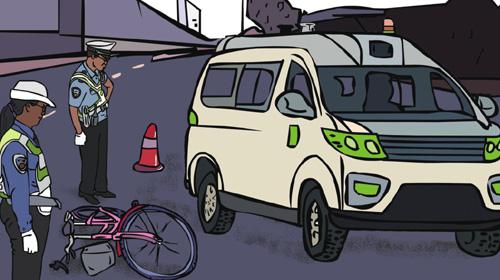Can Driverless Cars Be Safe?
2018-05-09

In March, a woman was hit by one of Ubers driverless cars while jaywalking from a median strip across two lanes of traffic on a highway in Tempe, Arizona. Her death, the fi rst case of a fatal pedestrian accident caused by a self-driving car, has raised the debates over who is responsible, as well as whether the testing of driverless technology should be suspended just as the number of autonomous cars being tested on the roads of cities around the globe takes off.
Innovation unstoppable
Ma Rong (News.zol.com.cn): The accident in Tempe has sparked a heated debate among the public. Opponents of driverless cars have taken this opportunity to push the government to limit the development of this new technology. Undoubtedly, this is a heavy blow to the driverless car industry.
Since they first appeared, opponents have never stopped doubting the safety of driverless cars. They argue that it is unwise to put our life in the hands of machines, and that traffic accidents are certain to follow. If we compare the figures, we will find that human-driven cars are more unreliable than driverless cars, and if autonomous vehicles were to completely replace human drivers, the rate of accidents would drop sharply because humans cannot compete with the processing power of computers.
Driving is the process of collecting information from the road and responding to it properly, but humans are actually not very good at this. Human eyes and ears cannot compete with the ability of advanced sensors to collect information, and the reaction speed of computers is much faster than the human brain.
As for the accident in Tempe, the point now is pinpointing the technical faults that led to the fatal crash and working out how to improve the current system instead of focusing on ethics or preventing the development of driverless cars.
New technology will always face obstacles in the early stages of its development. When automobiles and planes were first invented, aristocrats fond of carriages began to satirize them and doubt their safety. People should respect technology and approach these issues with a more rational and tolerant attitude rather than intimidation or irritation. The government also needs to work out a legal defi nition for responsibility in traffi c accidents involving driverless cars.
Hu Han (The Beijing News): Is the technology behind driverless cars posing a threat to safety on the road? A misjudgment may well ruin the emerging technology of self-driving vehicles. Disbelief in technology seems to have again bolstered the publics trust in human beings and the belief that to let humans behind the wheel is somehow safer. However, this blind judgment is not well-founded. Today, big data and sensor technology, as well as autonomous vehicles systems of logic to identify obstacles and their communications channels, have developed to such a high level that they are more reliable and safer than human drivers, rather than the other way round. Human errors resulting from drunk driving and poor driving skills are still unavoidable.
According to local police, in the Uber accident in Tempe, the woman was walking a bicycle from a median strip when she was hit by the self-driving car. It is a case of jaywalk- ing, and whether it had been a driverless car or a mistake by a human driver, it would have been diffi cult to avoid.
Nonetheless, this seminal case of death caused by a driverless car has ignited public concern about the technology, particularly since no one is clear on whom the accident should be blamed.
In ordinary traffic accidents, human drivers will be held accountable and thus manned cars are considered to be controllable. When it comes to driverless cars, there is no such individual in the car to be blamed. As a result, we are now faced with two extreme choices: to trust self-driving technology absolutely and its superiority over human beings, or to be extremely strict with its use so as not to allow any accident to come from it. Self-driving technology is now facing not only technical but also ethical challenges.
Xia Zhenbin (Legal Daily): At present, self-driving technology is becoming increasingly advanced off road. However, driverless cars must go through road testing before we can decide whether they are able to cope with this complicated real environment. Is it safe to let them run automatically on the road without a driver? It is hard to say.
Risks and obstacles are inevitable as we march toward technological innovation and exploration. Before the real cause of the selfdriving car accident in Tempe is clear, we cannot simply conclude that autonomous driving is unsafe and cease our exploration of this technology. Take conventional automobiles as an example. When they fi rst traveled on the road, many people were also against them, saying that they were too fast and dangerous compared with traditional carriages. But as traffi c lights were set up and transport legislation improved, concerns dissipated and cars became widely used.
The real meaning of on-road testing is to improve driverless technology so that it can be used in a real environment rather than in a simulated setting.
Undeniably, self-driving technology still faces many challenges, such as who should be responsible for accidents and whether this ethical dilemma can ever be fully resolved. The government is expected to impose stricter supervision while adopting a more tolerant and innovative attitude toward this new technology. Companies should make safety their first priority and further promote the development of technology for the benefi t of all citizens.
More preparation needed
Zhang Jinliang (News.zol.com.cn): Driverless cars are much more advanced than manned cars. In a simulated environment, Google and Baidus vehicles are already able to run independently, totally free of human control.
In some ways developers of autonomous vehicles seem to have already developed an overconfidence in their technologies. In the fatal crash in Tempe, the human operator behind the wheel who was supposed to monitor the technology and retake control in the case of an emergency or imminent crash did not respond in any way, probably because he believed that the automated system would respond properly to such conditions. If it had been a human driver behind the wheel as a pedestrian approached, they would have slowed down and sounded the horn.
Yet conversely, lack of confi dence in selfdriving technology may hamper its research and use. During road tests of self-driving vehicles, over-interference by human operators can only dilute the accuracy of testing data, making road tests meaningless and increas- ing the risks facing other road users.
At this stage, prudence is needed by the autonomous vehicle manufacturers and Internet companies behind the technology. The testing of these cars should be carried out step by step, from simulated roads to closed road sections and finally to open roads.
Yang Yuze (Changjiang Daily): The biggest challenge to driverless cars lies not in the technology they use. Self-driving technology involves sensation, calculation, decision and execution, and in these aspects, computers will soon catch up with humans. From the perspective of accident rates, driverless cars are much safer than conventional ones. The real problem is whether society has prepared itself for this new mode of driving.
Although driverless cars are based on computer calculations, they also need to follow transport rules. In this way, drivers can be freed from driving and the efficiency of transport will be improved. However, driverless cars will be very diffi cult to use if other cars rush across the streets and passengers cross roads without obeying the same set of rules. You can imagine a driverless car as a driver who strictly follows the rules. In this case, accidents are still hard to avoid when a car driven by a drunk person crashes into it.
Singapore is the country where driverless cars are the most widely used at present, and many of the companies focusing on driverless technology see it as the best testing ground because it already boasts good, orderly transport. Despite the fact that some developed countries have a well-developed code of driving conduct, driverless cars can still not be widely used there. Renowned Swedish automobile company Volvo decided to change the look of its driverless test cars so as to avoid being taken advantage of by human drivers.
Therefore, public awareness of traffic safety practices and societal order are also key for driverless cars to enter human life. There are also other obstacles for driverless cars to travel on the road. For example, no matter how developed the technology is, driverless cars still need human operators behind them. Who should take responsibility for a cars action? That is an unavoidable ethical question and legislation is still in the works.
